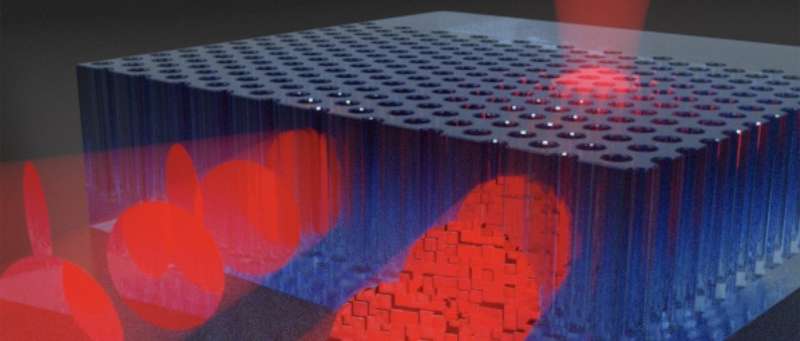Credit: University of Twente
Light that is sent into a photonic crystal can't go deeper than the so-called Bragg length. Deeper inside the crystal, light of a certain color range can simply not exist. Still, researchers of the University of Twente, the University of Iowa and the University of Copenhagen managed to break this law: They steered light into a crystal using a programmed pattern, and demonstrated that it will reach places far beyond the Bragg length. They publish their findings in Physical Review Letters.
Photonic crystals have a regular pattern of nanopores etched in silicon. They are typically designed to work as a mirror for a certain color range of light. Inside the crystal, light of those colors is 'forbidden." Even if you could place an atom inside the crystal that typically emits one color, it will stop emitting light. The so-called Bragg length is the maximum distance light is allowed to travel, according to a well-known physics law.
This property can be used for creating perfect mirrors for certain wavelengths and also improves solar cells. Still, if there is a sign that says 'forbidden' anywhere, it is always tempting to go there. The researchers proved that light can penetrate the photonic crystal much deeper than the Bragg length.
They managed to do this by using light that was pre-programmed and by using the small imperfections that always result from creating nanostructures. These imperfections cause light waves to scatter randomly inside the crystal. The researchers programmed the light in such a way that every location inside the photonic crystal could be reached. They even demonstrated a bright spot at five times the Bragg length, where light is enhanced 100 times instead of decreased 100 to 1000 times.
Stable qubits
This remarkable result can be used for creating stable quantum bits for a light-driven quantum computer. The 'forbidden effect' can also be employed in miniature on-chip light sources and lasers.
The paper "Spatially shaping waves to penetrate deep inside of a forbidden gap," by Ravitej Uppu, Manashee Adhikary, Cornelis Harteveld and Willem Vos will published in Physical Review Letters of 30 April and it is highlighted in Physics.
More information: Ravitej Uppu et al. Spatially Shaping Waves to Penetrate Deep inside a Forbidden Gap, Physical Review Letters (2021). DOI: 10.1103/PhysRevLett.126.177402
Steering Light Within a Crystal. Physics. physics.aps.org/articles/v14/s53
Journal information: Physical Review Letters
Provided by University of Twente























